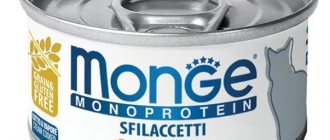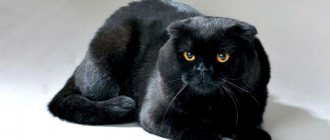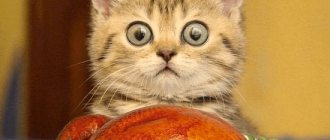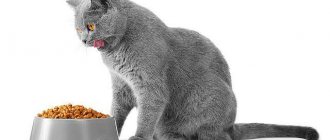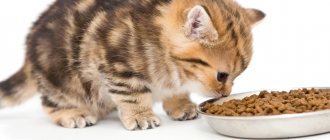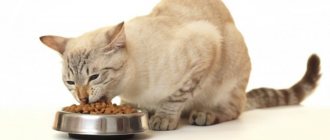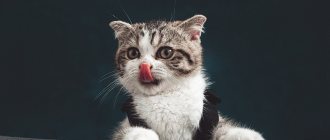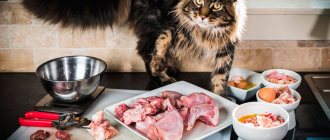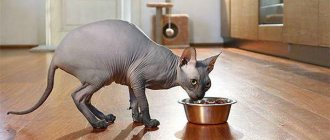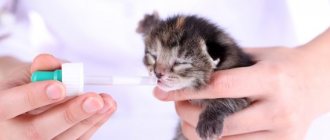The appearance of a Scottish kitten in a family is a joy for everyone, but also a great responsibility. It is necessary not only to equip a place for rest, to purchase everything necessary to keep a pet, but also to create a diet and decide what to feed the Scottish kitten. Regardless of the type of Scottish breed: Scottish Fold, Highland Fold - fold-eared kitten or Scottish Straight, Highland Straight - straight-eared kitten, from the first days babies need a balanced diet.
It is advisable to purchase Scots at 3 months of age, when kittens are weaned from breastfeeding. The owner is faced with the difficult task of how to create the correct nutritional system for the pet as it develops. The health and life expectancy of a Scottish cat depends on the quality, quantity and variety of food.
Selecting your diet
For all cats, including purebred Scots, three types of food are recommended:
- Homemade food with a variety of natural products.
- Industrial with ready-made food, dry or jelly-like.
- Mixed feeding, homemade food divided over time, alternating with ready-made food.
Each type of food is correct, the main thing is to follow the diet, the number of meals depending on the age and physical condition of the animal. It is important that food for Scottish kittens is always fresh, varied, and provides the necessary balance of vitamins and microelements.
When choosing the type of food, they are guided by the pet’s preferences, as well as the owner’s ability to devote a lot of time to preparing homemade food.
Vitamins
If the kitten is naturally fed, it must be given vitamin complexes. The emphasis is on fish oil, vitamins A, B and D. Giving your pet pharmaceutical vitamins intended for humans is strictly prohibited. In such preparations the concentration of useful substances is too high, as for animals, for this reason serious complications in the functioning of internal organs can occur.
Kittens who eat only industrial food do not need vitamins. Before choosing vitamin and mineral products, it is recommended to consult a veterinarian. When choosing vitamins on your own, you should choose multivitamins intended for the Scottish breed.
Properly organized nutrition for a new family member - a Scottish Fold kitten - is the key to the fact that the pet will grow up strong and healthy. To choose the right diet, it is recommended to consult a veterinarian, since a specialist will take into account all the characteristics of the breed and the tendency to certain diseases.
What to feed a Scottish kitten
Food for Scottish fold and straight-eared kittens is selected depending on age. The food is balanced, high in calories, and high in protein.
When eating at home, a diet is made from natural products with a high-quality selection and the right combination of ingredients.
Up to 2-3 weeks until the kittens open their eyes well, begin to run independently, and feed exclusively on the milk of the mother cat. Then they are fed by carefully introducing natural products into the food in liquid crushed form. They are taught to eat raw, well-frozen, finely chopped meat to prevent infection with worms. Be sure to include vegetables and fermented milk products in your daily food.
When they decide to feed their pet commercial ready-made food, dry or jelly-like, they choose manufacturers with high-quality premium products with a line “from 1 to 12 months” specially balanced for feeding kittens. Such complexes contain sufficient amounts of protein, carbohydrates, vitamins and minerals for the kitten’s growing body.
Important! During the period of breastfeeding, it is necessary to intensively feed the mother cat, whose body is severely depleted by childbirth, and intensive feeding of kittens.
1 month
The Scottish kitten is 1 month old, and additional nutrition is gradually being introduced along with mother's milk. All new food should be soft, diluted with milk. From this age, the kitten can be given clean bottled water, which is poured into a separate bowl and changed regularly, once a day.
Table No. 1. The diet of a one-month-old kitten may consist of:
Weaning food stored in the refrigerator is warmed to room temperature. At the age of one month they switch to feeding Scottish kittens 8 times a day.
2 month
A Scottish kitten that has grown up to 2 months becomes frisky and playful. His first teeth appear. For the proper development of an active, growing Scot, a higher calorie diet is required. Chicken yolk mixed with minced meat is added to maternal nutrition and daily complementary feeding products. Switch to raw, pureed vegetables and fruits. The total volume of food is 120 grams, including breast milk. Gradually, the kitten is separated from its mother, reducing breastfeeding.
Two-month-old kittens can be gradually transferred to industrial food. The food is purchased from a high premium class, balanced with the age of the kitten. Dry food is soaked in milk or water; soft food is better processed by the stomach. It is more advisable to feed a kitten with wet canned food, enriched with vitamins in accordance with the age of the kittens.
3 month
A three-month-old kitten, already completely switched to food, is given to another family for upbringing and a place to live. When a purebred Scottish kitten is sold, the owner is given a fully completed certificate (passport), which indicates all vaccinations received against feline infections with the date of revaccination.
The new owner receives advice from the breeder on what to feed a Scottish kitten at 3 months. A sudden change in a kitten’s diet affects the functioning of the digestive system and can lead to diarrhea and vomiting.
At home, the pet is transferred to 6 meals a day with an increased amount of food up to 180 grams. Dry food is not soaked, meat is given in pieces; kittens at this age have already fully formed dentition.
Meat products are mixed with pureed raw vegetables with the addition of bran from various cereals. Porridge cooked in water is introduced into the diet, also in combination with meat and vegetables.
After 3 months, a Scottish kitten can be completely switched to industrial high-quality, premium food, taking into account the age category.
4 month
At 4 months, Scottish kittens already look like their breed: fold-eared or straight-eared. The animals are fed 4-5 times a day, but more intensively, bringing the amount of food to 240 grams per day.
The diet remains the same in terms of food composition, so what to feed the Scotsman is a resolved issue; there is no need to come up with something new. The pet’s gastrointestinal tract is fully formed, the proportion of meat (beef, poultry, rabbit) is increased, with larger cuts, so that the jaw develops and the teeth are sharpened. The recommended amount of meat is 160 grams per day. Mineral and vitamin complexes purchased at a veterinary pharmacy are added to the porridge with pieces of vegetables.
For kittens transferred to industrial food, it is better to purchase ready-made dry and wet food products from one manufacturer with a diverse line of composition according to the age of the kittens.
Scottish kitten weight by month
When keeping a Scottish kitten, it is important not only proper care and a rationally formulated diet, but also control over maintaining weight within acceptable limits, especially in a newborn kitten up to one year old.
The size and weight of a Scottish fold and straight-eared kitten depends on:
After birth, babies develop quickly but unevenly. Body weight and weight up to 5 months in Scottish Straight and Fold kittens develops rapidly, but then the growth rate decreases.
Weight and height are influenced by the diet of the mother cat and additional feeding of the babies. At 5 months, the weight of a boy's Scottish kitten can reach from 2.6 to 4.3 kg and he looks well-formed and nimble.
Much depends on how the mother cat's pregnancy proceeded. With proper nutrition, healthy offspring appear in the litter.
The rate of growth and weight depends on the sex of the Scot; cats are always larger than female cats.
The appearance is influenced by the genetic characteristics of the parents; a large species of cat and female cat give birth to the same kittens.
Table No2. Weight of a Scottish kitten by age from birth to one year.
Introduction of complementary foods
At an early age, the basis of the Scottish Straight kitten's diet is milk, cat milk substitutes and various mixtures. When the baby reaches 2.5-3 months, you can gradually introduce new natural products into his menu. An excellent option for first complementary foods are:
- dairy products (milk, cheeses);
- high-quality minced meat;
- fermented milk products (kefir, sour cream, fermented baked milk, yogurt).
Industrial food is introduced into the diet of a Scottish Straight kitten at the age of 3 months.
Initially, it is recommended that children be offered high-quality mousses, pates, and jellies. Before the baby reaches six months of age, it is best to pre-soak dry food in kefir or milk.
Adult pet diet
The structure of the digestive system of all cats is not particularly different, therefore, for an adult cat from the Scottish Fold and Straight-eared species, the food does not differ in composition. The main thing is to provide your pet with a varied, high-quality and balanced diet.
Table No3. Diet of an adult Scottish Fold or Straight-eared cat.
Dry and wet food
Ready-made food from manufacturers of dry and wet products has the following advantages:
- Convenient for feeding, it is produced in production in the form of mixtures: - pastes, pieces of jelly, canned food and dry pads. Doesn't take much time to cook.
- The composition fully takes into account the cat’s need for a complex of beneficial substances for the body with the addition of vitamins, minerals, and herbal ingredients.
- For each type of product, a dosage of the daily amount required for a balanced diet has been developed.
- The mixtures include natural products processed using a special technology that ensures long-term storage.
Food is produced in different categories: holistic, super-premium, premium, economy class, consistent with the age of the kitten.
The finished food is easily digested by the animal’s body and is eaten with pleasure.
When switching Scottish cats to ready-made food, you must adhere to the following feeding rules:
- Choose only high-quality food for feeding Scottish fold and straight-eared purebred cats: holistic, superpremium, premium class.
- Strictly follow the manufacturer's recommended daily or single dosage of the product indicated on the packaging.
- You can feed your pet in two modes:
- One-time, once a day, the entire amount of food is laid out in a bowl. So, it’s convenient to feed your pet for busy owners.
- Portioned, the entire daily dose is divided into shares and given to cats according to a time schedule. More useful for the cat, there is no threat of obesity.
- The animal is constantly provided with free access to water. Use bottled liquid and replace it with fresh one daily.
Important! It is advisable to decide what kind of food is best to feed your pet and choose products from one manufacturer that are age-appropriate. This will ensure control over the supply of nutrients in food.
Recommended food from finished product manufacturers for Scots: Royal Canin, Hill's Science Plan, FLATAZOR CROCKTAIL, Sanabelle.
Table No. 4. Popular companies producing cat food.
Natural nutrition
There is no doubt about whether it is worth feeding a Scottish kitten regular food and what food is best for kittens. Tasty, fresh food, natural in composition, close to the natural nutrition of animals. Properly selected food prepared from a variety of products will please your baby. When eating natural foods, vitamin complexes are additionally included in food.
Important! Breeders and veterinarians believe that natural products are much healthier than ready-made branded products in the form of canned food, pouches and dry food.
For the owner, daily cooking creates certain difficulties and requires a lot of time. Many people cut up a large complex amount of food in advance, including meat products, vegetables, eggs, herbs, for a week. The entire prepared mass is laid out in portions into bags and frozen. Use daily, giving to the pet after heating.
There are two power modes:
- Constant, when the daily amount of food is immediately placed in a large bowl. And the pet eats everything as desired. This regime is convenient for busy owners, but there is a risk of cat obesity.
- Portioned, when food is given out in small quantities several times a day, the cat gets used to not overeating, which is good for his health. This makes feeding convenient for those who are constantly at home and can maintain an hourly schedule.
Important! The natural nutrition basket of the Scottish fold and straight-eared cats consists of meat, vegetables, fermented milk, eggs, herbs and other products. Occasionally, you can pamper your pet with fish, seafood, and fruits.
is it possible to give milk
It is not recommended to give milk to adult cats due to the high lactose content. It can be replaced with fermented milk products as a source of calcium. Particularly important is low-fat cottage cheese, which is given 2 times a week, on other days kefir and fermented baked milk.
Meat
Meat is an obligatory daily product in the diet; its daily content makes up up to 70% of the total food. Scottish cats, known as mousecatchers, benefit from raw meat. It is well frozen in advance to get rid of parasites. Meat products include: beef, chicken, all other types of poultry except fatty breeds. All types of offal: stomachs, liver, heart, kidneys. The meat is cut into large pieces so that the pets develop jaws and sharpen their teeth.
Fish
Fish and seafood are very beneficial for cats, necessary for the growth and strengthening of bones. Low-fat varieties of any sea fish: hake, pollock, perch and other types are freed from bones and scalded. Included on the menu infrequently: 1-2 times a week. It is not recommended to give river fish, it is very bony and can damage the stomach.
Porridge
Buckwheat, barley, wheat, pearl barley, oatmeal porridge. They are cooked until fully cooked in water or milk, add a few drops of vegetable oil: Olive, flaxseed, sunflower. Porridges are mixed daily with meat, fish, and vegetables in a ratio of 1:3 of the total volume. Do not add salt or sugar. Recommended as complementary food for kittens from 5 months.
Basic rules for feeding kittens: how to feed a Scottish Fold and Straight-eared kitten
The kitten's diet must be balanced, because... otherwise, he will face problems with stool, vomiting, diarrhea, and abnormal development.
Nutrition should be limited to a time frame: small straight-eared and fold-eared kittens are fed 5-6 times a day, adolescents - 3-4 times a day, adult cats - 2 times a day (morning and evening).
The kitten should have its own bowls that cannot be washed with chemicals. Bowls should be placed in a quiet place where nothing disturbs the kitten: if the animal is nervous while eating, this will negatively affect its health.
It is also important to know what to feed your Scottish kitten. The kitten should have constant access to water, also in a quiet, protected place. The water should be changed every day. It is advisable to choose a container large enough, because... cats love larger “ponds”. And they are especially fond of running water: to imitate it, you can buy a special cat fountain, but do not allow them to drink from the tap: it contains harmful chlorinated water. The bowl of water should not be placed in the same place as the food: cats like to drink away from the place of feeding, which is dictated by wild instincts - water near food can become infected with poisons.
The kitten should eat often and in small portions, because... otherwise, the body will have difficulty digesting what is eaten, and this will lead to hiccups, vomiting and other consequences. Of course, the cat doesn’t mind eating 200 grams at a time, allotted for a day, but the owner must monitor the quantity limit: put in a bowl as much as the kitten can eat at one time, without reserve.
Additionally, vitamins are included in the kittens' diet. Read more about them in a separate article.
We also recommend that you familiarize yourself with general nutrition data for cats.
Article continues after advertisement
Diet for a pregnant Scottish cat
Feeding a pregnant cat requires special attention to an enhanced diet and more frequent feeding. Not only the female is provided with food, but also the emerging babies in her womb.
Feed, both industrial and natural in composition, should contain not only healthy products: meat, fish, vegetables, cereals, fermented milk, but also a complex of vitamins, minerals, protein, and microelements. For the formation of embryos, the mother needs taurine, fatty amino acids, calcium phosphorus and other elements. Ready-made food for Scottish cats should be holistic or super premium, which has a specialization for pregnant cats.
What to feed a pregnant Scottish Fold and Straight-eared cat is determined by the period of its condition. It is conditionally divided into 3 stages:
- The first three months (trimester) of pregnancy are not externally detectable, but the Scottish cat's appetite increases. The diet remains the same, the volume of food increases by 30 grams. It is important not to overfeed a pregnant cat. The frequency of meals is gradually increased to 5 times a day in small portions.
Attention! Some cats may develop toxicosis and develop an aversion to certain food ingredients. Unpleasant foods are removed from the diet during the first trimester.
- During the second trimester, embryos actively grow, the volume of food gradually increases to 2 times
- During the third trimester, your cat's appetite may decrease significantly. The embryos have already gained normal weight and body shape; they do not require increased nutrition. During this period, there is no need to force feed the Scottish cat; she regulates her own needs and instinctively prepares for childbirth.
Important! If there is constipation during pregnancy, cats are given boiled beets or supplemental drinks in their diet.
Feeding after childbirth
How to feed a Scottish Fold cat after giving birth depends on her condition and the number of kittens in the litter. The animal becomes weak in the process of bearing and giving birth to babies; it needs increased high-calorie nutrition to restore and produce milk. But for the first few hours after lambing, the cat refuses to eat, which is natural for her condition. You need to monitor your pet’s well-being and offer to drink water or heated milk diluted with kefir.
Attention! Prolonged refusal of water after birth leads to dehydration of the cat's body. To restore, give the cat lightly salted water with sugar or dilute the Regidron solution. In a severe, protracted case, seek help from a veterinary clinic.
The amount of food depends on the number of kittens born, the age of the cat itself and the type of food it previously received.
When feeding industrial products, the manufacturer remains the same, but premium food is selected, specially designed for the postpartum period of cats. They are supplemented with nutritional supplements that stimulate lactation to ensure adequate nutrition for babies. For Scottish fold and straight-eared cats, Royal Canin products are suitable, dry food with a high vitamin and protein content. The first days after birth, dry food is soaked in low-fat broth or milk.
When feeding a Scottish cat with natural products before pregnancy, the diet is not changed, but foods that increase lactation, such as milk, and more often kefir and cottage cheese, are added. During the first few days, the meat is ground into a blender and diluted with broth. The menu must include vegetables, fish, and herbs.
AlpenHof
Tasty treats are a good addition to your cat's main diet and a way to show her your love. AlpenHof offers mini sausages made from rabbit, lamb and duck, chicken hearts and veal. The delicacies are prepared using meat drying technology. The product retains vitamins due to the absence of heat treatment. The drying temperature is 40 °C. Sausages and hearts are prepared from high-quality natural meat without fat and veins. This is a dietary product that can be used to pamper kittens and adult cats with sensitive digestion, allergies or excess weight.
Every treat from the AlpenHof range contains a lot of protein, which provides energy and well-being. They can replace up to 10% of the daily diet. The variety of types allows you to choose a treat that your cat will like. According to reviews from owners, hearts and sausages smell nice and their pets really like them.
Source
What not to feed
The health of your pet depends not only on a properly formulated diet, but also on knowing what not to feed your Scottish Fold or Straight-eared cat.
It is strictly forbidden to include the following products and additives in the diet of a fold-eared, straight-eared Scottish kitten:
- Any types of sweets and confectionery products lead to obesity
- It is unacceptable to feed Scottish Straight and Scottish Fold kittens chocolate.
- Lard, fatty meats and fish affect the liver;
- Adding salt, hot spices, pickles and marinade to food harms the kidneys and stomach;
- Fried, smoked meat and fish are poorly digested and harm the pancreas;
- Canned food contains salty, peppered foods with spices that are harmful to digestive and urinary function.
Important! Do not teach your Scottish cat to eat anything from the common table; such food is harmful to the pet’s health and develops bad behavior habits.
Advice from veterinarians
Veterinarians' advice on what to feed Scottish fold and straight-eared cats:
- Before purchasing a beloved pet, it is useful for owners to:
- get acquainted with the peculiarities of feeding Scottish fold and straight-eared kittens;
- Find out at the cattery what Scottish cats eat at birth and in what quantities.
- When feeding Scots, it is beneficial to use ready-made, high-quality specialized feed:
- Practically, it is much easier to acquire a solid supply of feed;
- Ease of use, no need to cook food;
- Cost-effective, it is more profitable to purchase balanced feeds than to buy the entire range of products separately.
- Long shelf life, unlike natural products.
Pets, Scottish fold and straight-eared cats, need proper and balanced nutrition. It is important from the first days of a kitten in the house to organize care, to take into account the nuances of nutrition during the growth of the pet at all stages of development, taking into account the characteristics of the breed.
Prohibited Products
There is a whole list of what should not be given to Scottish Fold cats:
- fatty meat (pork and lamb);
- smoked, dried, salted meat products;
- river bony fish;
- fresh cow's milk;
- raw eggs;
- legumes, potatoes, garlic, onions;
- citrus;
- sweets and baked goods.
Eating unwanted foods can lead to gastroenterological diseases and allergic reactions.
How often should I give food?
A small and an adult Scottish Straight pet needs to be fed differently. Animals from 1 year old are given food 2-3 times a day, babies - more often, 3-4 times. Over time, the older Scottish Straight is fed less frequently. It is important that the diet for a cat at any age must be balanced, containing vitamins, minerals and other necessary components. The animal should not be overfed or, conversely, put on a diet. It is recommended to consult a veterinarian first.
Source
Calorie norm
A sufficient amount of calories for a pet is considered to be one that provides the cat with high activity, maintains the required body temperature, and allows the digestive, respiratory and cardiovascular systems to function normally. The average daily intake of an adult cat is 200-300 J per kilogram of weight.
Thus, a pet weighing 3 kg needs about 1000 J daily, cats weighing 4 kg need 14 J, cats weighing 5 kg need 1500 J.
For reference: a person needs about 10,000 J per day. Taking these requirements into account, below are two sample menu options for an adult Scot.
Option 1:
- 25 g beef or veal;
- 5 g lung;
- 10 g water;
- 2 g vegetable oil;
- 5 g yeast;
- 4 g cereal flakes.
Recipe 2:
- 10 g liver;
- 25 g lean fish;
- 4 g buckwheat;
- 7 g water;
- 0.2 g yeast;
- 5 g low-fat cottage cheese.
The food prepared according to each recipe can be divided into portions and frozen for the future - at any time you can take the bag out of the refrigerator, defrost it and quickly feed your furry pet.
Feeding Scottish Straight
Owners of cats of different breeds should familiarize themselves with the rules for caring for their pet. There are several recommendations on how to feed the Scottish Straight. Representatives of this cat breed rarely have digestive problems and are in fairly good health. Proper feeding of an animal is the key to its normal development, excellent mood and longevity.
Breed Features
The Scottish Straight is a cat breed, also called the Scottish Straight, similar in appearance to the British cat.
These animals have a calm disposition and a strong attachment to their owner. They are peaceful creatures, the key to calm and peace in the home. They are less picky when it comes to food than the Highland Fold. The owner of a cat of this breed needs to understand that it is important to devote time to your pet, show love and affection, and follow the necessary rules of care. A balanced diet will ensure good health for your cat.
The Scottish Straight is a clean creature; the owner only needs to comb it 2-3 times a week and bathe it from time to time. Despite the short length of the coat, it is necessary to monitor and care for it regularly. Caring for a Scottish Straight is easy; it doesn’t require a lot of time or financial expenses. It is important to choose the right diet, since the animal’s quality of life depends on it.
The room where the pet lives should not be warmer than 23 degrees.
For your pet to feel well, the indoor temperature should be 20-23 degrees Celsius. To properly care for the coat of Scottish cats, you should purchase special combs and shampoo. In addition, cats need to periodically clean their ears, trim their claws and wash their eyes with cotton pads when they become watery.
